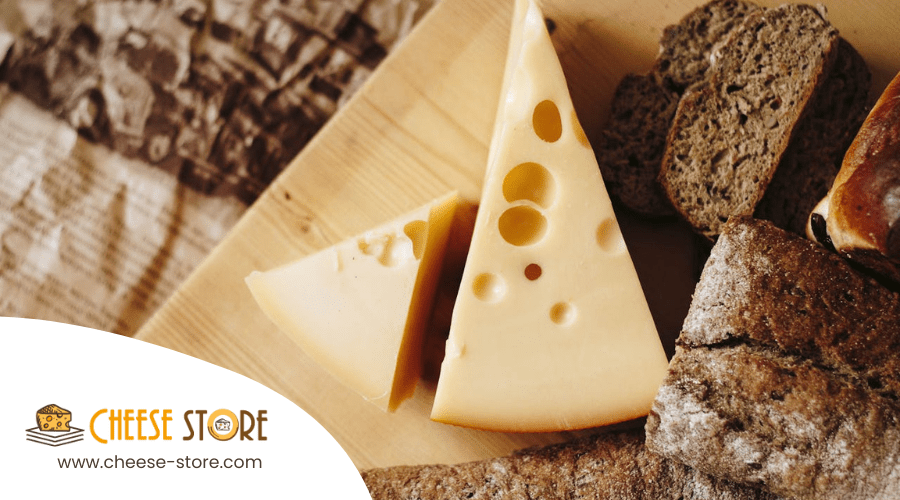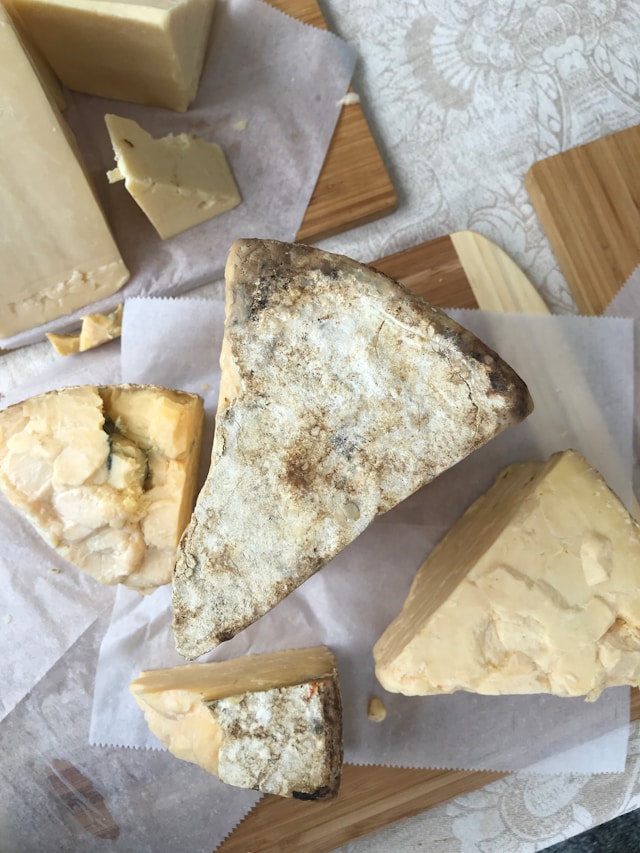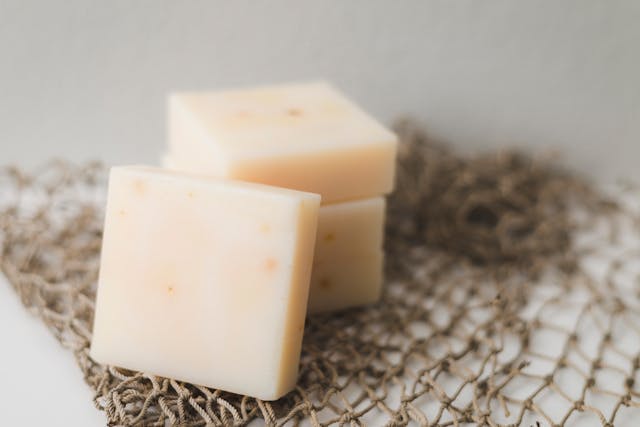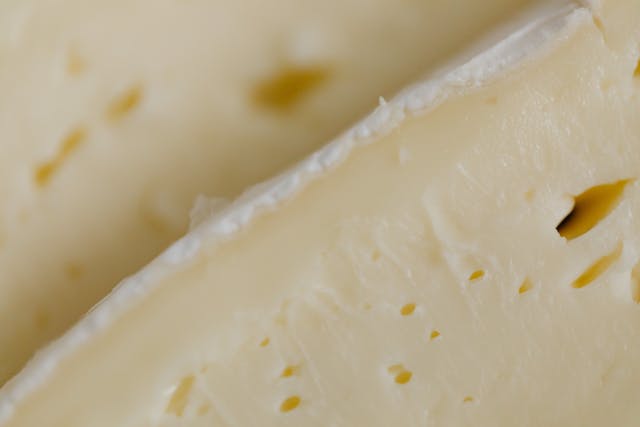Just as Pandora couldn’t resist opening her box, you might find yourself intrigued by the enigmatic world of cheese aromas, particularly why some cheeses have a scent reminiscent of feet. You’re about to step into a domain where microbes such as Brevibacterium linens are the unsung heroes, meticulously crafting the distinctive smells that either allure or repulse cheese enthusiasts. This microbial action, coupled with enzymatic reactions and aging processes, gives rise to the complex bouquet of aromas found in cheeses. If you’ve ever wrinkled your nose or savored the pungent whiff of a ripe cheese, understanding the science behind these olfactory experiences might just change your perspective. So, why do some cheeses share their aroma with something much less appetizing? The answer lies in a fascinating interplay of biology and chemistry that awaits your curiosity.
Key Takeaways
- Bacteria like Brevibacterium linens produce sulfur compounds, leading to pungent, foot-like cheese smells.
- Enzymes such as lipases and proteases break down fats and proteins, creating complex aromatic compounds.
- Aging enhances enzyme activity, deepening cheese aromas and contributing to distinctive foot-like odors.
- Different cheese varieties develop unique aroma profiles through tailored aging processes, influencing their scent intensity and complexity.
The Role of Bacteria
Bacteria, like Brevibacterium linens, play a pivotal role in crafting the unique aromas and flavors of cheeses such as Limburger by thriving in the cheese’s warm, humid conditions. When you bite into a piece of this cheese, you’re experiencing the work of these bacteria. They’re introduced during cheese production and find the environment ideal for their growth. As they consume lactose in cheese, they produce volatile compounds, including sulfur compounds, which are key to the cheese’s distinctive smell.
You might wonder why some cheeses smell like feet. Well, Brevibacterium linens is closely related to the bacteria responsible for human body odor, particularly the kind that gives feet their notorious smell. This connection explains why the sulfur compounds produced by Brevibacterium linens in cheese can remind you of foot odor. These compounds, including methanethiol, are what give cheeses like Limburger their unique aroma. It’s a fascinating interplay of microbiology and culinary art, where bacteria and molds are not just tolerated but celebrated for the depth of flavor and complexity they add to cheese. Through their activities, Brevibacterium linens and similar strains turn a simple dairy product into a delicacy with an unforgettable aroma.
Enzymatic Reactions Explained
As you explore the world of cheese, it’s fascinating to see how enzymes break down proteins, playing a pivotal role in creating those distinctive aromas. Bacteria, too, are key players, working alongside enzymes to shape the cheese’s smell, especially as it ages. This aging process allows for the development of a rich and complex aroma profile, making each cheese uniquely tantalizing to your senses.
Enzymes Break Down Proteins
When you savor the complex flavors and aromas of cheese, it’s thanks to enzymes breaking down proteins into smaller, aromatic compounds. These enzymes, like lipases and proteases, are the unsung heroes in cheese production, meticulously crafting the unique scents we either love or shy away from. Through their work, they release volatile sulfur compounds, such as methanethiol, which are key players in the distinctive foot-like aroma in some cheeses. Understanding this process demystifies why certain cheeses have such potent smells.
| Enzyme Type | Role in Cheese Aroma |
|---|---|
| Proteases | Break down proteins into peptides, enhancing flavor complexity |
| Peptidases | Further reduce peptides to amino acids, intensifying aroma |
| Lipases | Target fats, contributing to creamy and pungent scents |
| Sulfur compound release | Leads to foot-like odors |
Bacteria’s Role in Aromas
Delving into the world of cheese aromas, you’ll find that bacterial enzymatic reactions play a pivotal role in crafting those distinctive, foot odor-like scents. Bacteria like Brevibacterium linens are at the forefront of this aromatic journey. They break down amino acids, setting off a cascade of reactions that lead to the creation of:
- Methanethiol, a sulfur compound known for its pungent smell.
- Other volatile compounds that contribute to the cheese’s overall aroma.
- Complex sulfur compounds, enriching the cheese’s scent profile.
- A diverse range of aromas, including those reminiscent of feet.
These enzymatic activities by bacteria are essential in generating the unique, sometimes divisive, aromas associated with certain cheeses. Understanding these reactions offers insight into the intricate world of cheese production and the role of bacteria in shaping flavor and smell.
Aging Process and Smell
Building on the foundation laid by bacterial activity, the aging process further amplifies cheese’s aroma through a series of enzymatic reactions. As cheese ages, enzymes like lipase and protease get to work, breaking down proteins and fats. This breakdown not only changes the cheese’s texture but also releases a mix of volatile compounds responsible for that distinct smell you either love or hate.
| Enzyme | Impact on Cheese Aroma |
|---|---|
| Lipase | Breaks down fats, forming aromatic compounds |
| Protease | Splits proteins into amino acids, leading to characteristic odors |
These enzymatic reactions interact in the aging process, creating a blend of compounds that result in the unique, sometimes foot-like aroma of certain cheeses. It’s the controlled enzymatic activities during aging that give well-aged cheeses their rich, pungent smells.
The Impact of Aging
Aging’s important role in cheese production deepens flavors over time, intensifying and diversifying the aromas you experience. When you explore into the world of cheeses, you’ll find that aging is a vital step that transforms a simple dairy product into a complex flavor experience. The smell of cheese, particularly those pungent aromas akin to feet, owes much to the aging process. As cheeses age, they undergo a series of chemical reactions that contribute to their unique smell.
Here’s how aging impacts the aroma of cheeses:
- Deepening Flavors: The longer a cheese ages, the more its flavors mature, becoming richer and more robust.
- Complex Aromas: Aging allows for the development of unique, sometimes unexpected aromas that can surprise and delight the senses.
- Pungent Smells: Certain cheeses are known for their foot odor aroma, a direct result of aging conditions and the breakdown of specific compounds.
- Distinct Identity: The aging process gives cheeses their characteristic smells, setting them apart from fresh varieties.
Understanding the impact of aging on cheese aromas helps explain why aged cheeses boast such pungent and complex smells. It’s this transformation that makes aged cheeses a sought-after delicacy for many.
Cheese Storage Fundamentals
To guarantee your cheese retains its best flavor and texture, it’s important to master the fundamentals of proper storage. Proper cheese storage isn’t just about keeping it from spoiling; it’s also about ensuring those unique cheese smells stay pleasant, not overwhelming or absorbed by unwanted odors. Wrapping your cheese tightly in wax paper or plastic wrap is important. This method prevents air exposure, maintaining freshness and preventing the cheese from drying out or absorbing other smells in your fridge.
Storing your cheese in the refrigerator between 32°F and 40°F is essential to inhibit bacterial growth and preserve its quality. Remember, placing cheese near strong-smelling foods can result in your cheese taking on those aromas, which might not be what you’re aiming for. To keep your cheese experience ideal, always check the expiration date on the packaging. This ensures you’re enjoying your cheese within its best timeframe.
Lastly, avoid cross-contamination by using clean utensils and hands, especially with shredded cheese. This step is important to prevent spoilage and maintain the quality of your cheese. With these proper storage tips, you’ll ensure your cheese’s smells and tastes remain as intended, enriching your culinary experience.
Brevibacterium and Aromas
Diving into the science of cheese aromas, you’ll find that Brevibacterium linens plays a pivotal role in creating the distinctive, foot-like smell present in some cheeses. This bacterium, thriving in the salty and humid conditions also found on human skin, is behind the characteristic aroma of cheeses like Limburger. It’s fascinating to note that the same bacteria contributing to foot odor are also enhancing your cheese experience.
Brevibacterium linens breaks down amino acids into methanethiol, a compound responsible for the pungent smell. This process is not random but carefully managed by affineurs, who cultivate the bacterium to not only develop the cheese’s smell but to improve its texture and flavor. Here’s how Brevibacterium linens impacts your cheese:
- Thrives in conditions similar to human skin, making it a common factor in both cheese and foot odor.
- Contributes to the unique smell of cheeses like Limburger and Munster.
- Breaks down amino acids, releasing methanethiol.
- Is managed by affineurs to enhance the cheese’s overall sensory qualities.
Understanding the role of Brevibacterium linens deepens your appreciation for the complex world of cheese aromas, where microbiology meets gourmet delight.
Different Cheese Varieties
You’re about to explore how different cheese varieties develop their unique aroma profiles, from the sharp tang of blue cheeses to the distinct foot-like odors of washed-rind varieties. We’ll examine the role of aging processes and how they intensify these characteristics. Understanding these nuances will give you a deeper appreciation for the intricate world of cheese aromas.
Cheese Types Overview
Exploring the world of cheese reveals a vast array of types, each with its unique flavor profile and textural characteristics. You’ll find that:
- Cheddar cheese is renowned for its sharp, tangy flavor, which becomes more pronounced with age.
- Brie cheese delights with a soft, creamy texture and a bloomy rind, offering a mild taste that’s hard to resist.
- Gouda cheese, hailing from the Netherlands, impresses with its smooth, buttery consistency and a sweet, nutty flavor that’s truly unforgettable.
- Beyond these, there’s a whole world of cheeses like blue cheese and Parmesan, each undergoing unique production processes that yield rich and distinctive tastes.
Exploring these varieties, you’re commencing on a flavorful journey that spans the globe and tantalizes the palate.
Aroma Profiles Explored
Embarking on a sensory journey, it’s intriguing to uncover how different cheeses emit unique aromas, each telling a story of its origins and production process. The aroma profiles of cheeses like Limburger, known for its feet-like scent, to the nutty and fruity notes of Parmesan, are shaped by specific bacteria and mold cultures.
| Cheese | Aroma Description | Contributing Factor |
|---|---|---|
| Limburger | Strong, resembling feet | Brevibacterium linens |
| Roquefort | Sharp and tangy | Penicillium roqueforti |
| Parmesan | Nutty and fruity | Aging Process |
| Camembert | Creamy and earthy, mushrooms | Penicillium camemberti |
| Taleggio | Pungent, tangy and earthy | Bacterial and mold cultures |
Each cheese’s unique scent offers an insight into the art of cheesemaking, from the selection of specific bacteria to the intricate aging processes.
Aging Process Impact
Delving into the aging process reveals how it greatly shapes the aroma of different cheese varieties, enhancing their unique characteristics. When you explore why cheese that smells varies so widely, you uncover the aging process impact on each distinct aroma.
Understanding the aging process is key to appreciating the diverse aromas in various cheeses. Here’s why:
- Flavor Deepening: Aging allows flavors to intensify, influencing the ultimate smell.
- Specific Techniques: Each cheese undergoes unique aging methods contributing to its aroma.
- Essential Parameters: Temperature, humidity, and duration are essential in developing distinct smells.
- Variety Influence: Different cheeses require tailored aging processes to achieve their characteristic scents.
Next time you encounter a cheese with a particularly pungent aroma, remember the complex interplay of aging techniques at work behind the scenes.
Identifying Spoiled Cheese
Identifying spoiled cheese is important to make sure you’re not consuming something that could be harmful to your health. While smelly cheese might be part of the cheese aromas experience, there’s a difference between the complex scents of maturing cheese and the foul smell of spoiled cheese. Spoilage can transform the delightful experience of cheese tasting into an unpleasant one.
To help you distinguish between the unique smell of cheese and signs of spoilage, here’s a quick guide:
| Sign of Spoilage | What to Look For |
|---|---|
| Visual Appearance | Fuzzy or discolored patches indicating mold growth. |
| Texture | Sliminess, stickiness, or clumpiness. |
| Smell | Foul or ammonia-like odors. |
Choosing Quality Cheeses
To make sure you’re enjoying the best, it’s important to know how to select quality cheeses. With the vast array of different types available, it can be a challenge to distinguish between the ones that will elevate your culinary experiences and those that might just remind you of body odor.
Here are a few key tips to remember:
- Seek Out Pleasant Aromas: Quality cheeses should greet your nose with inviting smells. If it reminds you of feet more than food, think twice.
- Check the Aging Process: Properly aged cheeses develop a complexity that’s hard to replicate. Look for signs that the cheese has been cared for throughout its maturation.
- Steer Clear of Off-Putting Odors: While cheese smells can vary widely, strong foot-like odors often signal spoilage or mishandling.
- Trust Reputable Sources: Opt for cheeses from producers known for their high standards and attention to detail, ensuring you get the best aroma and flavor.
Conclusion
So, you’ve ventured into the fascinating world of cheese aromas, learning how bacteria like Brevibacterium linens are the unsung heroes behind those distinctive smells. From enzymatic reactions to the aging process, and the importance of proper storage, it’s clear that a lot goes into crafting that perfect cheese aroma. Whether you’re exploring different varieties or keen on spotting quality cheeses, remember, even if some smell like feet, it’s all part of the rich tapestry that makes cheese so intriguing. Keep sniffing and savoring!




